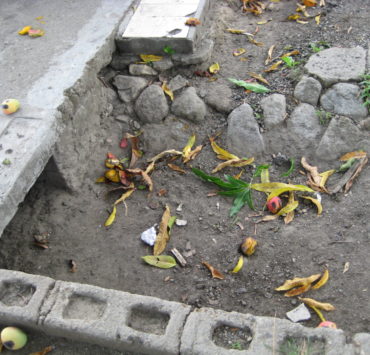
At a Christmas gathering at a cousin’s house in Maryland I mentioned to my five-year-old nephew that I don’t own a television. I was sitting on a couch with him paging through a book about whales and dolphins for the sixth or seventh time. The men in the family were playing gin rummy around the coffee table; the other children were playing video games on their parents’ cell phones, and the women were in the open kitchen off to the side making a succession of meals. At that moment and the whole weekend long the flat screen TV that hung above the fireplace was lit and muted. Images of CNN commentators discussing the murder of two NYPD officers, Red Wing hockey and young men singing love songs in music videos formed the backdrop of the holiday. “What’s that?” my nephew asked. I looked down at the creature on the page and said, “Some kind of dolphin, I’m not exactly sure.” But I had misunderstood the question. He spoke again: “What’s television?”
*
*
“Look at this. This looks like a city. Like a little model of a city. And all the houses, which are here. And streets. This is maybe an elevator to go up, up there. And here are all the wires. These wires, they really take care of all the electrons when they come through there. They take care that they are powerful enough to get all the way through to here.” This is how the musician Björk, describes the circuit board and wires of a television in an old video. She has opened the back of the television, she says, because it’s Christmas time and she’s been watching lots of television and is curious about how it works to cast its spell on her. She sits at a kitchen table affectionately close to “the beautiful television” and says she wants to understand “how it can put me in all sorts of situations.”
In her quest to understand how television works Björk posits a tongue-in-cheek cultural battle between her native Iceland and its former colonizer, Denmark, framed as a battle between poetry and science. She describes how an Icelandic poet explained to her that television was different from film: “This is millions and millions of little screens that send light, some sort of electric light, I’m not really sure. But because there are so many of them, in fact you are watching very many frames when you are watching TV. Your head is very busy all the time to calculate and put it all together into one picture. And then because you’re so busy doing that, you don’t watch very carefully what the program you are watching is really about. So you become hypnotized. So all that’s on TV, it just goes directly into your brain and you stop judging if it’s right or not. You just swallow and swallow.” Björk says that the Icelandic poet’s explanation caused her to become so frightened of television that she began to get headaches while watching it.
The cure for poet-induced headaches, she suggests, trying to remain deadpan, is science: “Later on, when I got my Danish book on television, I stopped being afraid because I read the truth, and that’s the scientifical truth, which is much better.”
She concludes,”You shouldn’t let poets lie to you.”
Several years ago when I lived in Cambridge my thirteen-inch Sony CRT television was seated on a spare, antique, steel chair. The chair, which had a thin, metallic-ribbon spine supporting a small, back panel was turned to the side to accommodate the depth and bulk of the television; the back of the television case hung over the edge of the chair. It was certainly a precarious setup, but I felt that there was something oddly elegant in how the two objects lived precariously together. I doubt anyone else would have thought so, however. It looked like a temporary arrangement you’d make until you bought a proper media console or TV stand. Except we never did. I’d sit on a chair as I watched the television, sitting on its own chair.
Maybe a year went by and one day I came home to find the back case of the television missing. My boyfriend had apparently knocked the television over and now the case was cracked. We kept the television on the chair with all its nerves exposed. I worried that it was a fire hazard to have the cathode tube, the wiring and the circuit board exposed and hanging over the chair, but we weren’t going to buy a new television. Moreover, the opened box went even more beautifully with the old metal chair; I liked the look of it. I did sometimes feel, though, that we had split open the television’s head and what we now saw plainly was like the coils of someone’s brain.
When I left my boyfriend and Cambridge I thought of taking the television back with me to New York. It had begun its life with me years before in Manhattan as an inadvertent piece of installation art. For the first few months after I moved into my studio apartment I had little furniture other than a bed and desk. The television was placed on the floor in the empty apartment and because without cable there was no reception, it functioned mostly like a small piece of furniture. At times I turned it on in order to have its snow animate my bare space.
Years later, as I prepared to return to New York I wanted to see what would become of it with its open head wound, whether it would eventually rot or fray or explode. I wanted to see it through its life span. It wouldn’t have surprised me if it one day it sparked a fire; if dust built up on the circuit board and wiring like a blanket of snow; or if some kind of spore or seed began to grow in its intricate landscape. I knew, of course, that I could not take it with me in its vulnerable state. I left it there with its copper and its colored wires dangling above the metal chair, and with that I left television more generally behind.
*
Sometime in the late 90’s in India I went with a cousin to his ancestral village, where he wanted to visit an elderly relative and discuss a bit of family business. I recall slipping off my chappals outside a thatched-roof, whitewashed brick house and walking into the front room, while my cousin and his grand-uncle, a tall, thin man who stooped and wore a faded white lungi, went into an interior room to conduct their business. There were no chairs in that front room. Sacks of paddy rice lay piled on the floor and against one wall there was a small television on top of a wooden bench. I saw images of blonde women in red one-piece bathing suits on the television.
Looking at scenes from Baywatch in this old farmer’s house I felt amazed and scandalized, as if television itself had come into its adolescence here. (I somehow think of these lines from a poem by Elfriede Jelinek: “the three popes/ proclaim/ the revolution/ against teenage television.”) I have varied memories of watching television in India. After we’d brought a Sony Trinitron from the U.S. for my aunt, her neighbors would regularly gather in her living room to watch old movies together. Later, when my grandfather no longer went to his club to play cards in the evening, I would sit with him while he drank his daily scotch to watch the nine-o-clock Telugu news. But the programming that I most consistently remembered from my time in India, the programs that, in my mind, stood for Indian Television, itself, were the agricultural reports on Doordarshan, the national (and for many years only) television channel. If I had walked in to find agricultural reports on the television at that old man’s house, I would have felt that all was just as it ever been.
Once when visiting another cousin I remember talking about her toddler daughter, my niece, in the third person, the way one talks about a baby, as a being who is there but whose presence you can’t fully gauge. It had been a few months since I’d last seen her. Suddenly, to my surprise the little girl began talking to me, and I realized that she had been aware of what I’d said. Through language she had suddenly asserted her consciousness. She became alive to me in a new way.
In that little house near some rice fields in India, television had come alive to me in a new way, like an infant who begins to speak or a child newly wearing the expressions of adolescence. After all those years of state programming and agricultural reports, to think of an old Indian villager watching Baywatch in his thatched house made me feel as if, for better or for worse, that television had just been turned on. It was now in full transmission mode.
*
The show “Nam June Paik: Becoming Robot”, which I saw at The Asia Society in New York provided a wonderful opportunity to rediscover television. Paik, who is often described as the father of video art worked extensively with technology, and the show at The Asia Society included numerous works that he’d made with television sets. I had last seen Paik’s work in the late 90’s and while I admired his work back then, I found that I could really see it much more clearly now. I imagine that his work would have been quite interesting to see in the late 60’s as well. By the 90’s, though, television boxes were ubiquitous; they no longer signaled a technological future, nor did they really evoke the past. In 2015, however, television is no longer necessarily connected to that old object; television programming no longer needs the television itself. We watch screens, and mostly they are flat or folding. In this context, especially, I found it quite moving to visit Paik’s robot family, assembled out of bulky television monitors. With Nam June Paik as a guide I could re-imagine the television as a body, as a being, on standby ready to transmit not only radio (or digital) signals but also its own particular aura.
*
My nephew had asked me “What’s television?” These are a few of the thoughts I might have had in that span of time, an instant, before his father looked up from his card game and said, “television means TV.”
Images:
1. Painted televisions displayed on a street in Saint Louis, Senegal
2. Nam June Paik, “Family of Robot”
3. Nam June Paik, “Golden Buddha”
Previously published at: www.3quarksdaily.com

Madhu Kaza was born in Andhra Pradesh, India and grew up in Detroit, Michigan. She is currently an educator, writer and artist based in New York. Much of her work is informed by her astonishment at everyday life.







